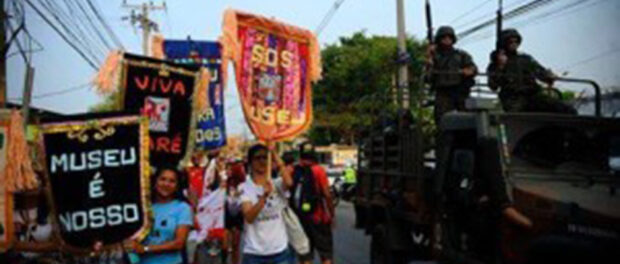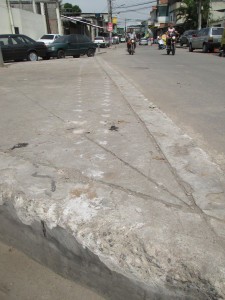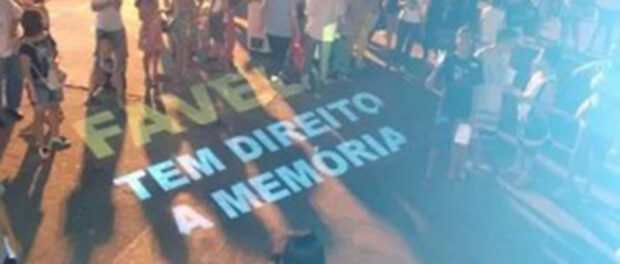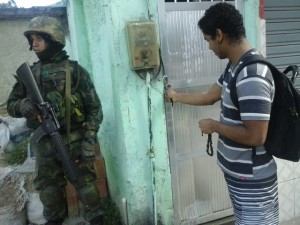
For the original in Portuguese, by Miriane da Costa Peregrino, published in Vozes das Comunidades, click here.
Faced with threats of eviction, residents speak out in defense of the museum
Museu da Maré celebrated nine years on Friday May 8, but has been facing threats of eviction since last September by the owner of the building where it has been located since 2003, when it was known as the Maré Cultural Center. A unique initiative in the areas of social museology and the preservation of favela memory, the museum was created in 2006 by a group of residents of Complexo da Maré as a project of the Maré Center of Solidarity Studies and Actions (CEASM), and occupies a property donated by the Libra Group, which requested the devolution of the property when federal troops entered the area.
On October 18 of last year, staff, supporters and Maré residents organized a protest along Avenida Brasil against the eviction. Since then, the threat of eviction has continued. The Municipal Council for Culture approved the legal protection of the Museum’s collection in September of last year, but Mayor Eduardo Paes has still not approved the decree.
Thamires Ribeiro, a Maré resident and student of Conservation and Restoration at the Rio de Janeiro Federal University (UFRJ), 24, says the museum eviction “would be a terrible loss for the community that has the Museum not only as a space for theater, dance and reading, but also as a place of memory that plays a key role in preserving and telling the story of Maré.” The student explains, “this process happens through the help of Maré residents, who go to the museum and identify with the place, unlike what happens in most museums in Rio de Janeiro, where people, especially the residents of favelas, do not feel represented in that space.”
Luiz Lourenço, 29, Maré resident and student of Geography at UFRJ, says he identifies with the museum as a preservation tool for the memory of Maré and supports the museum’s continuity: “As a cultural device, the museum should not be evicted, and to me that is a fact! The museum was born the same way as the favelas, through self-construction, which is why I identify with it, making a cultural break from the inside out.”
Maré resident and Law student at the Rio de Janeiro State University (UERJ), Lydia Felix, 24, talks about her relationship with the museum: “I train capoeira at the museum and was really sad to hear the news [of the eviction]. I am not following the case closely, but I share online petitions and collect signatures from neighbors and friends. The museum is fundamental for Maré residents: it tells our story. It is a space created by residents, for residents. The museum rescues the identity of the favela and our resistance. In addition, numerous activities are held in this space (capoeira, zumba, ballet, etc).
When she learned of the threat of the museum’s eviction, resident and journalist Renata Souza, 32, promoted an online petition against the eviction: “I contacted Meu Rio, which is an NGO that organizes online petitions to press the government, to prevent the museum from being evicted. We managed to recruit a couple thousand people to press the government by sending direct emails to the Department of Culture,” said Renata Souza.
Despite the initiatives of residents and museum staff reaching out to the cultural secretariats (at the municipal and state levels), in those first stages the secretariat that emerged in support of the museum was the state’s Tourism Secretariat.
“Late last year, the state of Rio de Janeiro, through SETUR (Tourism Secretariat) and ITERJ (Institute of Land and Cartography of the State of Rio de Janeiro), supported the museum. Tourism Secretary Claudio Magnavita created SETUR Resolution 93 of November 24, 2014, which was published in the DOERJ on November 25, 2014, creating a Special Working Group. Because of this we were able to extend the initial period of the eviction notice from December 10, 2014 to March 10, 2015. In addition, the Museum was recognized by the State Board of Tourism as a priority tourist destination in the State of Rio de Janeiro, on December 10, 2014,” says Claudia Rose Ribeiro da Silva, the museum’s coordinator.
She continues: “With the departure of Magnavita from his post as Secretary, SEC (State Culture Secretariat) took on the defense of the Museum within the state government. Along with IBRAM (Brazilian Institute of Museums) and the City’s Culture Secretariat, SEC created a new working group to discuss actions to ensure that the museum could stay in the same location. The SEC Resolution No. 594, which established the Special Working Group, was established by Secretary Eva Doris and published in DOERJ on February 20, 2015. The Working Group has already had two meetings and managed to arrange a conversation with the board of the Libra Group. Secretary Eva Doris took a letter of support for the museum signed by herself, the city council Secretary of Culture, Marcelo Calero, and the chairman of IBRAM, Carlos Roberto Brandão, to this meeting. In addition, CEASM submitted, at Libra’s headquarters, a letter requesting further extension of the eviction date so that we could have more time to coordinate actions aimed at staying in this location.”
Public safety, real estate speculation, evictions and tourism: public policies for the mega-events in Maré
For residents who follow the situation of other favelas in Rio de Janeiro where Pacifying Police Units (UPPs) were installed, it is clear that public policies, whether local, state or federal, benefit those who are outside the favelas. Lydia Felix is one who claims that “the museum’s eviction is linked to real estate speculation and the state’s desire to make favela culture invisible.” In fact, in all the favelas in which UPPs were established, we can see that public security policies are followed by hikes in real estate prices, evictions and tourist development projects.
Although the main objective of the military occupation of Maré is to ensure control of the main access roads to the city of Rio de Janeiro and guarantee the safety of mega-events, real estate speculation and tourism are also important issues, albeit not to the same extent as in South Zone favelas like Vidigal, Rocinha and Santa Marta. The discourse of the state government’s tourism office reinforced this fear in Maré residents: in interviews, the secretary at the time always focused on the importance of the museum as an attraction for foreign tourists without mentioning the relevance of the space for the residents of the community, reversing the logic that guided the creation of the space in the first place.
Resident Luiz Lourenço notes that tourism is growing around the world as a lucrative economic sector, but points to the target audience of this industry: “Tourism is currently the third most lucrative economic sector in the world, second only to the oil and car industries, and can be used as a form of social development and income generation for the favela if local residents are actively involved in the process as workers and entrepreneurs. The memory of the favela needs to be preserved and promoted, positive memories and also the negative memories; following the military occupation I believe the visitor rates to the Museum will increase. However, who is it that will come? For the construction of a real favela memory it is necessary that visitation is not only by people from outside the favela, but also favela residents from Maré who have not yet visited the museum as well as favela residents of Alemão and Providência, who can, from their experience of the museum, create their own local museums.”
For resident Renata Souza, the threat of eviction against the museum is a consequence of the property speculation following military occupation: “Nothing is random, right? So when militarization happens here and the museum is then threatened with eviction we cannot help but relate one thing to another. Favelas where UPPs are being installed are going through a land valorization process. Then your land is more expensive because there are police and basic services are more expensive, an increased cost of living. So, in the process, to dislodge the museum, which is located in a super strategic place… The museum is 100, 200 meters from Avenida Brasil, which is a very strategic place for them to do whatever they want. We have a tourism process going on within the favelas and it’s no wonder the main government project in Complexo do Alemão is the cable car. For whom is the cable car? It’s for the resident? No, it’s for tourism in the favela. No one asked if the residents wanted a cable car or basic sanitation; if they did, they ignored the residents’ needs on purpose. In other words, today you have a giant cable car, but every time it rains there’s a flood with open sewers. Basic services are still precarious, but the government would rather do other things that attract the attention of tourists.”
Renata Souza explains that Maré is a much targeted territory by the authorities because it cuts through the main roads of the city: “The army comes here with the clear objective of giving a sense of security to those coming for the Games. When the army arrived here, it was a few days prior to the 2014 World Cup… They sent a message like: ‘We are dominating this space for those who are coming from abroad to feel safe in our wonderful city.’ Wonders may be in Rio’s postcards, but in terms of life in the favela this idea of the ‘wonderful city’ is very questionable. For me, in the favela, wonderful is a Sunday afternoon when I can sit in front of my house, have my beer and play my stereo. But the moment that the army comes and says that I cannot do that… how wonderful is it?”
It is important to remember that on July 22 of last year about 30 families had their homes demolished in the favela Salsa e Merengue, which constitutes part of the Maré Complex, and nothing was said about it in the media. The area was of interest to the City for the construction of a government project called Tomorrow’s School Factories. On the other hand, more than 30 families living in precarious conditions in the MacLaren area continue unassisted by the State. They have been registered with the City for more than five years, want to be relocated, but are still there, living between the Yellow Line highway viaduct and the open sewage drain, hidden behind a wall dubbed the Wall of Shame, because, after all, the area they occupy is not of interest to the government or the private sector.
Readers who do not know or do not remember where the MacLaren favela is might remember the morning of March 30, 2014, when the first wave of soldiers entered Maré, the largest collection of favelas in Rio de Janeiro, and raised the national flag beside open sewage. This is near where the MacLaren community lives, in shacks without sanitation and with only one water spout, in one of the poorest areas of Maré.
The legacy of pacification forces: More guns and less culture, health, education…
The image of the protest in defense of Museu da Maré last October, with activists sharing the street with the pacifying forces, seems to represent a scale where the comparative weights of culture and public safety are revealed. Antonio Carlos Vieira, director of the museum, spoke about the situation in Maré after the military occupation and during the current UPP implementation process: “The current situation is one of permanent tension. The occupation that is being conducted, in my opinion, is wrong because it transfers a public safety issue to the military, that is, army forces that are trained for war. This ends up causing the attacks we have witnessed, with violent approaches that end up resulting in the deaths of innocent people. I also see that there is a strong psychological factor at play with the presence of armed men in defensive postures, even in terms of the residents, compounded by heavy weapons and the constant movement of army tanks. This situation undoubtedly generates a collective trauma, with unknown consequences for the children of the community. In terms of violence, in Maré we currently live in one of the most difficult periods for the residents and for all around here. Instead, the high cost of maintaining the current occupying force could be used for social projects that can actually change the awareness and world views of the community’s young people,” says the director.
Both residents and non-residents who work in Maré are living in a tense atmosphere. Marilene Nunes, Maré resident and coordinator of Museu da Maré’s library, tells us how the space is often used as refuge during clashes and shootings in the museum’s surroundings: “A few weeks ago I was here in the library and suddenly a shootout started. I went running to close the front gate. We went to hide in the reserve. The other day, at 5:30pm, another shootout started. I went out to close the gate, but this time, I could not do it because while I tried to close the gate the people passing on the street were pushing to get in here. They were students of Bahia School, residents… A woman came in a car, parked the car by the museum door and came in, desperate. And shots were being fired. It was the army, the police, the boys. It was more than half an hour of shooting. We were inside the building and the shooting was going crazy on Guilherme Maxwell Street.”
A resident, who declined to be identified, says the movement of tanks by the pacifying forces has caused damage to the already fragile infrastructure of the favela: “The tanks break pipes and we are the ones who fix them later.” The tanks also leave scuff marks on the streets and sidewalks. “These are the marks of democracy for those of us in the favela,” concludes the resident.
 Since the beginning of this year, it has been reported that the federal troops are leaving Maré by July 2015 and that the the Military Police will come in gradually to implement the UPPs. The first batch of policemen came in at the start of April to Roquette Pinto and Praia de Ramos and the second batch on May 1, to Nova Holanda, Nova Maré, Rubem Vaz and Parque União. The recent protests against the UPPs—particularly the one on February 23 that occurred after a series of cases of abuse by pacifying forces and deaths in Maré during Carnival—and the need to “re-occupy” Complexo do Alemão in April point, once again, to the failure of the UPPs as a public security policy and the State’s authoritarian approach to intervention in the favelas.
Since the beginning of this year, it has been reported that the federal troops are leaving Maré by July 2015 and that the the Military Police will come in gradually to implement the UPPs. The first batch of policemen came in at the start of April to Roquette Pinto and Praia de Ramos and the second batch on May 1, to Nova Holanda, Nova Maré, Rubem Vaz and Parque União. The recent protests against the UPPs—particularly the one on February 23 that occurred after a series of cases of abuse by pacifying forces and deaths in Maré during Carnival—and the need to “re-occupy” Complexo do Alemão in April point, once again, to the failure of the UPPs as a public security policy and the State’s authoritarian approach to intervention in the favelas.
Memories from yesterday, fights of today
It is in this context of intense dispute over the territory and its symbolic goods that the threat of the museum’s eviction exists, and it is a dispute guided by interests that are certainly beyond those of visible property speculation. Extensions in the eviction deadline do not solve the situation: they ease the pain but do not cure the illness.
It is important to remember that hosting visitors is part of the function of any museum, be they community-driven or not, but the genealogy of Museu da Maré goes beyond that: it is a museum by residents for residents, a museum that promotes the favelas and subverts the logic of the ruling class, encouraging the creation of other community museums in different favelas, inspiring the development of a public policies to preserve the memory of the popular classes, such as the Ministry of Culture’s Points of Memory Program.
Anyone who has visited Museu da Maré knows its permanent exhibition is divided into 12 thematic eras. One of them is called Time of the Future, about the time being written in the present.
How to Visit
Location: Museu da Maré
Address: Avenida Guilherme Maxwell, 26 – Maré / CEP: 21.042-110 / Rio de Janeiro
Telephone: +55(21)3868-6748/3976-8779



